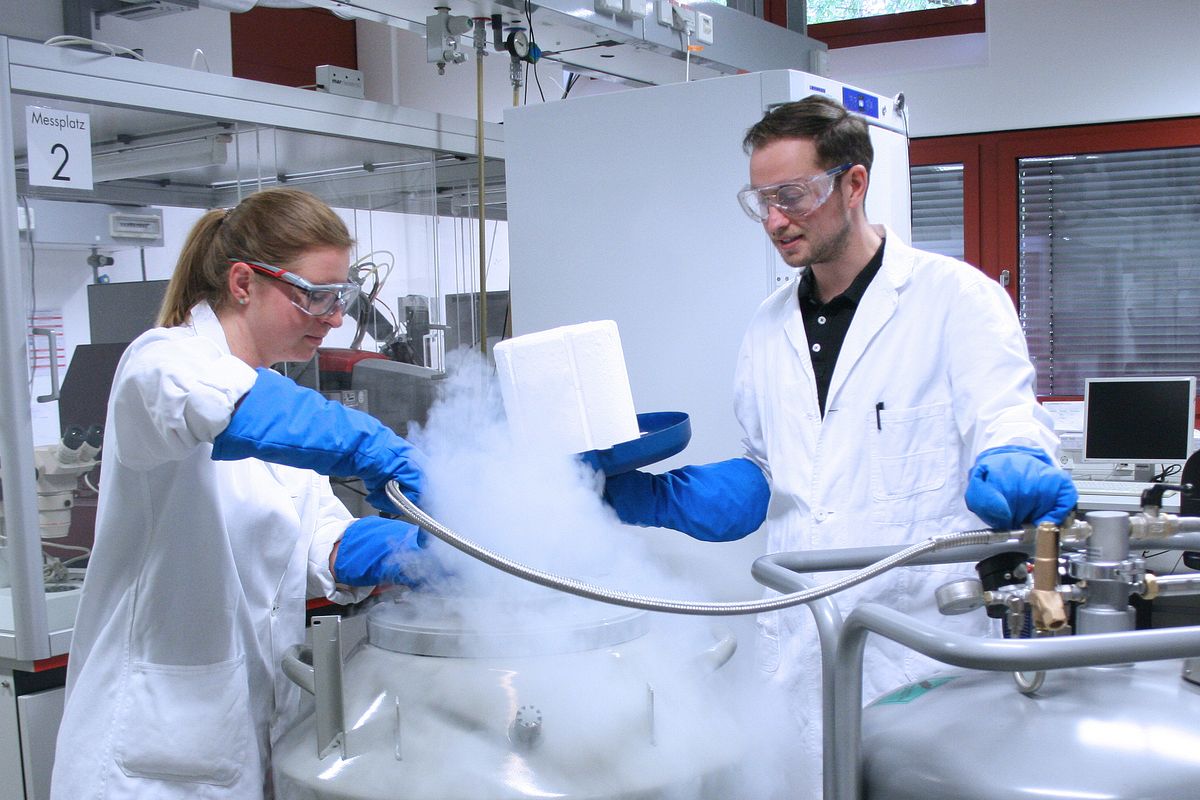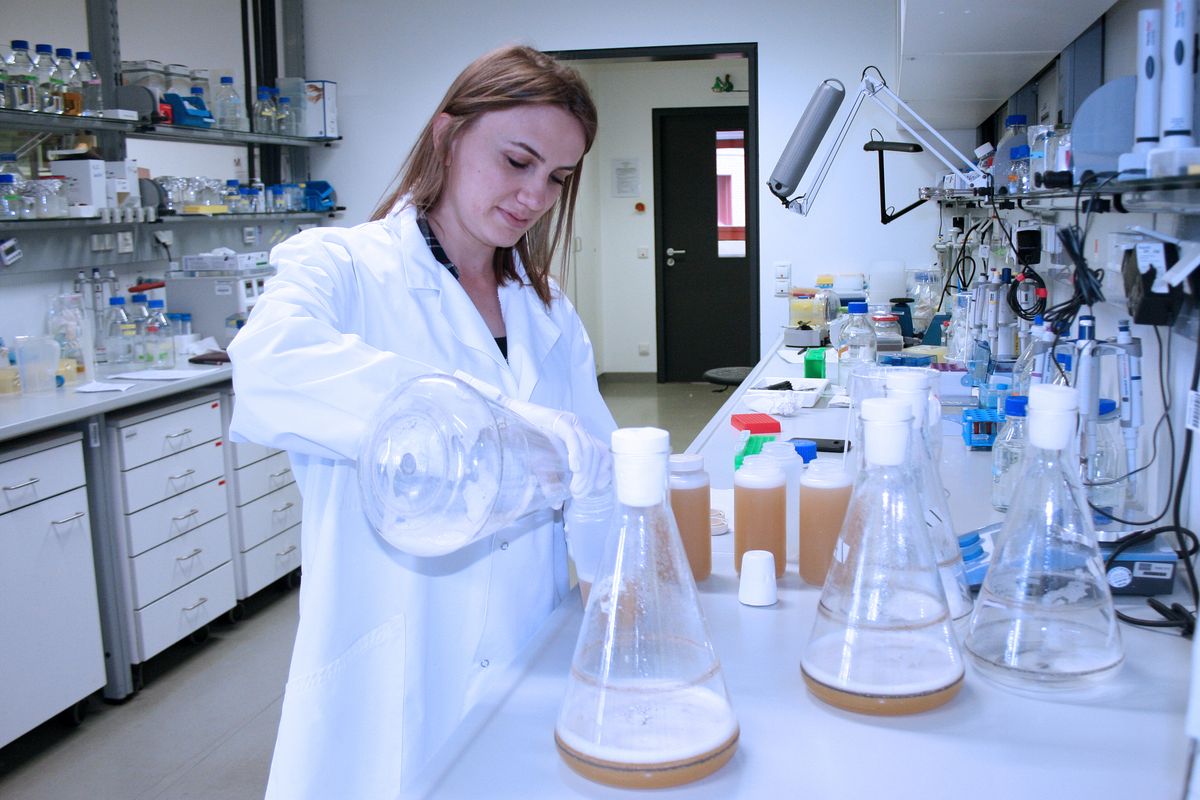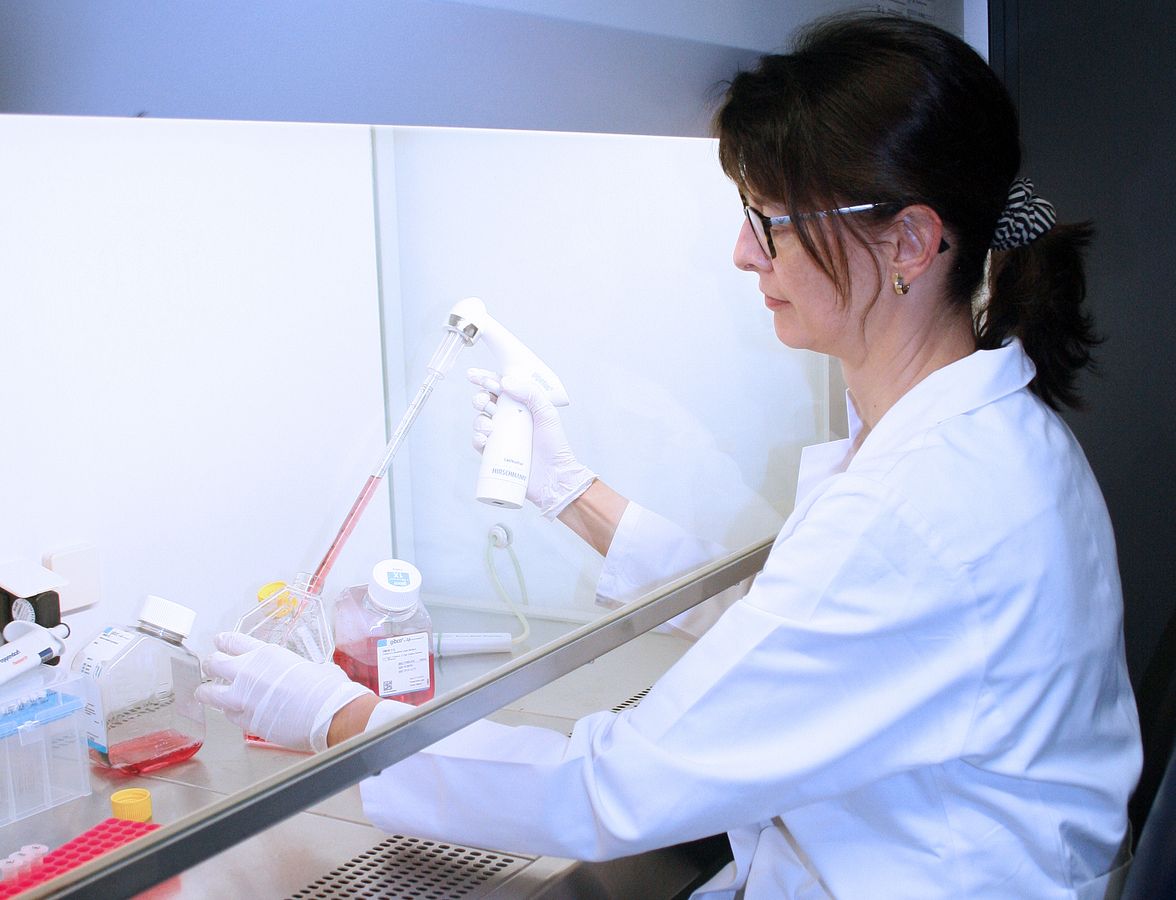In the following you will find information on the courses in the Bachelor's and Master's degree programmes in Chemistry. Our courses in the international Master's degree programmes in Chemistry are also listed here.
Bachelor modules summer semester
This 5 CP module is read by Prof. Hoffmann and Prof. Sträter and is intended for the 4th semester. It consists of 2 SWS lecture and a practical course.
Aims
Overview and understanding of modern separation methods and their applications.
Contents
Basics of chromatographic separation methods, gas chromatography, liquid chromatography, electrophoresis, mass spectrometry, GC-MS, LC-MS, separation of proteins and nucleic acids, protein precipitation, centrifugation, ultrafiltration, dialysis. Structure and properties of peptides, proteins, DNA and RNA. Bioanalytical basics.
This 5 CP module consists of lecture and seminar and it is read by Prof. Hoffmann and Prof. Sträter. It is held in German with English technical texts. It is intended for the 6th semester.
Aims
Imparting in-depth knowledge of important bioanalytical research methods, application of the methods and interpretation of the results in the context of typical questions.
Contents
Topic of the lecture are basic methods for the characterisation of peptides and proteins and their structure elucidation. In detail, basic bioanalytical methods (two-dimensional gel electrophoresis, MS), spectroscopic methods (optical rotational dispersion, CD, IR, static and dynamic light scattering, small-angle X-ray scattering, surface plasmon resonance, fluorescence polarisation and other fluorescence-based methods) and further physical methods (QCM, microcalorimetry, microthermophoresis, differential scanning fluorimetry) are covered. Application examples of these methods will be discussed in interactive seminars, with a focus on the combined use of the methods discussed in the characterisation of highly purified peptides and proteins (during and after separation procedures), and in molecular interaction (protein-protein, protein-ligand, enzyme catalysis, drug discovery).
This 5 CP module consists of an internship and it is carried out in the working groups of Prof. Hoffmann and Prof. Sträter. It is scheduled for the time between the 5th and 6th semester or for the end of the 6th semester. It should be carried out in preparation for the Bachelor's thesis.
Aims
Learning biochemical and bioanalytical laboratory methods in practice.
Contents
The topic of the practical course is biochemical basics and methods in the production and analysis of proteins and DNA: Protein analysis (protein precipitation, centrifugation, ultrafiltration, dialysis, chromatographic methods, concentration determination, electrophoresis, Western blot, immunological methods, mass spectrometry, UV spectroscopy, post-translational modifications), nucleic acid analysis (precipitation and purification, UV spectroscopy, gel electrophoresis, sequencing), protein production for structural analysis (molecular biology: Gene cloning, microbiological methods, isolation and amplification of DNA, PCR, mutagenesis, cell cultivation; recombinant protein expression: in vitro translation, protein folding) and peptides in biochemical research (peptide synthesis, peptide sequencing).
This 2 SWS lecture is held jointly by Prof. Oeckler and Prof. Sträter. It is part of the module ACIII (Solid State and Organometallic Chemistry), which is scheduled in the 4th semester.
Aims
Basics of symmetry of crystals, X-ray diffraction and crystal structure analysis.
Contents
Crystal symmetry and X-ray diffraction: Point and space groups, basics of X-ray diffraction, single crystal and powder diffraction, crystal structure analysis.
Bachelor modules winter semester
This module consists of a lecture and a seminar and it is read jointly by Prof. Ralf Hoffmann and Prof. Norbert Sträter. It is intended for the 5th semester.
Aims
Imparting in-depth knowledge of important bioanalytical research methods
Content
Topic of the lecture are biochemical basics and methods in the production and analytics of proteins and DNA. In detail the following methods are treated, which are essential for biochemical work:
- Protein analysis (protein precipitation, centrifugation, ultrafiltration, dialysis, chromatographic methods, concentration determination, electrophoresis, Western blot, immunological methods, mass spectrometry, UV spectroscopy, post-translational modifications)
- Nucleic acid analysis (precipitation and purification, UV spectroscopy, gel electrophoresis, sequencing),
- Molecular biology (gene cloning, microbiological methods, isolation and amplification of DNA, PCR, mutagenesis, cell cultivation)
- Recombinant protein expression (bacterial expression and cell culture, in vitro translation, protein folding)
- Peptides in biochemical research (peptide synthesis, peptide sequencing)
Bachelor thesis
The main goal of our work is to understand the structure and function of proteins at the molecular level. The topics of the bachelor's theses are predominantly of a methodological molecular biological and biochemical nature. The work is either for the preparation of protein for crystallisation and structural analysis or for functional studies by mutagenesis.
Please send an Email and we will clarify the availability of a topic and supervisor.
Organisation and timing
For a bachelor topic with molecular biological and biochemical working methods, the module "Bioanalytical Chemistry" should have been attended. The Bachelor thesis can then be carried out after the end of the 5th semester or during and after the 6th semester. Furthermore, it is recommended to combine the practical course "Bioanalytical Chemistry" with the Bachelor's thesis, so that there is sufficient time for familiarisation with the predominantly new working methods and an interesting topic can be successfully mastered within the framework of the Bachelor's thesis.
Topics and methods
We orient the bachelor theses quite close to current research work and a doctoral student or postdoc intensively supervises the work. Therefore, it is difficult to formulate the topics in detail far in advance.
In general, the following techniques are learned and applied methodologically in the assigned work, regardless of the project:
- Genetic engineering work to create expression vectors (construct design, cloning techniques, primer design, PCR, DNA analytics, DNA preparation, microbiological techniques).
- Mutation analysis (creation of mutants via quik-change mutagenesis)
- Gene expression and optimisation of expression conditions (cell culture techniques E. coli, HEK293, insect cells, protein analysis, SDS-PAGE, Western blotting)
- Chromatographic purification of proteins (usually by affinity chromatography (His-tag, Strep-tag, or tags for antibody columns) and size exclusion chromatography)
- Biophysical methods for protein characterisation (dynamic light scattering/aggregation, melting point temperature/stability, CD spectrum, UV/Vis spectrum)
- Protein crystallisation
- Enzymatic assays (mostly ecto-nucleotidases, detection of phosphate via malachite green assay, ITC assay)
- Binding assays (protein-protein, protein-ligand: microthermophoresis, ITC, fluorescence polarisation)
- X-ray structure analysis (in Bachelor theses usually only possible in already well-established projects with strong support from the supervisor)
Master modules winter semester
The 5 CP module consists of a 2 SWS lecture and a computer practical of 3 days. The lecture is intended for the first or third semester. The lecture takes place partly electronically and partly in presence. The lecture is held in English. The practical course usually takes place directly after the end of the lecture period.
Aims
Learning the basics and methods of protein crystallography and application in practice.
Contents
By means of the method of X-ray crystallography the spatial structures of organic molecules, inorganic solids as well as biological macromolecules can be determined to atomic resolution. In the lecture, the basics of these methods relevant for natural scientists are taught in a practical way. The focus is on biocrystallography. The following topics are covered, among others: Crystallisation, crystals, symmetry and space groups, X-ray sources and detectors, data collection, diffraction of X-rays and neutrons, phase problem, phasing and phase refinement, structure solution of low molecular weight compounds using Patterson function and direct methods, structure solution of biomolecules using molecular replacement, heavy atom replacement and anomalous dispersion, model building and
structure visualisation, structure refinement, validation and interpretation, comparison to structure determination by NMR or CryoEM.
Materials
The teaching materials will be made available for download via a password-protected weblink. The information will be given in the first lecture or by email.
News and results
The results of the written exam and current information will be communicated by posting on the password-protected website. After handing in the protocol for the practical course, the grade will be entered in AlmaWeb.
The 5 CP module consists of a computer practical course of 16 days. By choosing this module, the practical course in the module ”Protein Crystallography“ can thus be extended from 3 days to 3 weeks and it then corresponds to the 10 CP module of Protein Crystallography for Biochemists. The practical course also has seminar parts in which the exercises are explained. The practical course takes place directly after the practical course of the module ”Protein Crystallography“ (which in turn usually takes place directly after the end of the lecture period).
Aims
The students know methods for solving the spatial structure of proteins and DNA by means of X-ray crystallography. They are able to analyse, process, independently present and evaluate the topics under different objectives.
Contents
The basics for the determination of spatial structures of biomolecules by means of crystallography are taught. Each participant will be provided with a
laptop with the installed software and, after instruction, works independently through the following tasks (from diffraction images to protein structure) using detailed and partly interactive instructions on a website.
- Data reduction (indexing, integration ,space group determination)
- Structure determination of insulin with the SAD method (data reduction, phasing, interactive model construction of the whole insulin based on electron density, refinement of atomic coordinates, model validation, creation of images with Pymol)
- Structural analysis of protein-ligand complexes
Materials
The teaching materials will be made available for download via a password-protected weblink. The information will be given in the first lecture or by email.
News and results
Current information will be communicated by posting on the password-protected website. After submission of the protocol for the practical course, the grade is entered in AlmaWeb.
Master modules summer semester
The 5 CP module consists of two lecture parts of 2 SWS each. The part “Inorganic Biochemistry“ (or “Bioinorganic Chemistry“) is read by Prof. Hey-Hawkins and the part “Structural Biochemistry“ by Prof. Sträter. Both lecture parts will be held in German language from SS2021.
Aims
The students know the structure and function of proteins and enzymes as well as the role of metal ions in biological systems.
Contents
- Structural biochemistry:
Methods for determining protein structures, structural chemistry of proteins and DNA/RNA, visualisation of protein structures, characteristic folding types and oligomer structures, methods for determining spatial structures, protein database, structure and function of selected systems in the field of enzymes, membrane proteins, motor proteins, signal transduction, fibre proteins, etc., flexibility of proteins and conformational changes, protein folding, structure-based drug development. - Bioinorganic chemistry:
Occurrence and availability of elements, Typical bioligands, Biochemical role of metals, Physical methods, Oxygen cycle, Iron: Uptake, transport and storage, iron proteins, copper proteins, cobalamins, “Early“ transition metals: Mo, oxygen-transferring Mo enzymes, nitrogen fixation, nickel - urease / hydrogenases, zinc structural chemistry of proteins.
Materials
The materials on structural biochemistry are made available for download via a password-protected weblink. The information will be given in the first lecture or by email.
News and results
The results of the exam and current information will be communicated by posting on the password-protected website.
Master thesis

The main aim of our work is to understand the structure and function of proteins at the molecular level. The methods used in a Master theses are predominantly molecular biology and protein biochemistry.
Please send an Email and we will clarify the availability of a topic and supervisor.
For a Master's thesis with molecular biological and biochemical working methods, methodologically suitable elective modules (Wahlpflichtmodule) should have been attended.
Topics and methods
We orient the Master theses quite closely to current research work and a doctoral student or postdoc supervises the work. Therefore, it is difficult to specify topics in detail far in advance.
Information on our thematic research projects can be found here. The following are some typical methodological tasks that can be realised in a similar form for different thematic projects.
- Expression and characterisation of a protein
An essential prerequisite for the investigation of proteins is first the development of an effective protocol for the preparation of the protein in sufficient quantities. A project with this goal may include the following working methods: Construct design, cloning, expression assay and optimisation, preparative expression, purification (usually affinity chromatography and size exclusion chromatography), bioanalytical characterisation (monodispersivity: dynamic light scattering, stability: dynamic scanning fluorimetry, activity: enzyme assay or binding assay or biological assay. Once the protein has been purified to the desired quality, planned studies follow, for example crystallisation for X-ray structure analysis, enzyme assays and other functional studies. In our laboratory, bacterial expression in E. coli and expression in HEK293 cells are the most suitable expression systems. - Generation of variants and functional studies
Another common scenario is that a purification system for a protein has already been established in the laboratory, but now variants need to be generated and characterised. The motivation for this can be quite different:- The quality of the experimented protein is not sufficient (misfolding, aggregation, yield).
- The protein crystallises and variants should be designed and expressed for new screens.
- On the basis of a spatial structure, hypotheses for the functioning of the protein have been made and these hypotheses are now to be tested by mutations
- Comprehensive functional studies of a protein
Another typical type of topic concerns more comprehensive functional characterisation of a protein, for example enzymatic characterisation of an enzyme or ligand binding studies of a receptor. - Crystallographic studies
In a well-established project, crystallographic investigations can also be the subject of a Master's thesis. For example, the preparation and crystallisation of an enzyme according to an established procedure and subsequent binding studies of different substrates.

